Contemporary Management Report: RMIT University Analysis
VerifiedAdded on 2022/08/31
|10
|2209
|15
Report
AI Summary
This report examines contemporary management issues and challenges within the context of RMIT University, focusing on three key areas: technology and digital innovation, the operation of education in a global context, and ethical education within the higher education industry. The report highlights Singapore's education system as a case study, emphasizing the importance of digital integration, the impact of globalization, and the need for ethical considerations in leadership education. It discusses the challenges faced by RMIT University, such as adapting to technological advancements, managing rising costs, and maintaining a competitive edge in the global market. The report also emphasizes the importance of ethical leadership, the role of education in shaping future leaders, and the need for universities to adapt to constant changes to meet the demands of the modern world. The analysis includes discussions of the 'SkillsFuture' initiative in Singapore and the factors contributing to quality education and ethics management. This report provides a comprehensive overview of the contemporary management landscape in higher education.
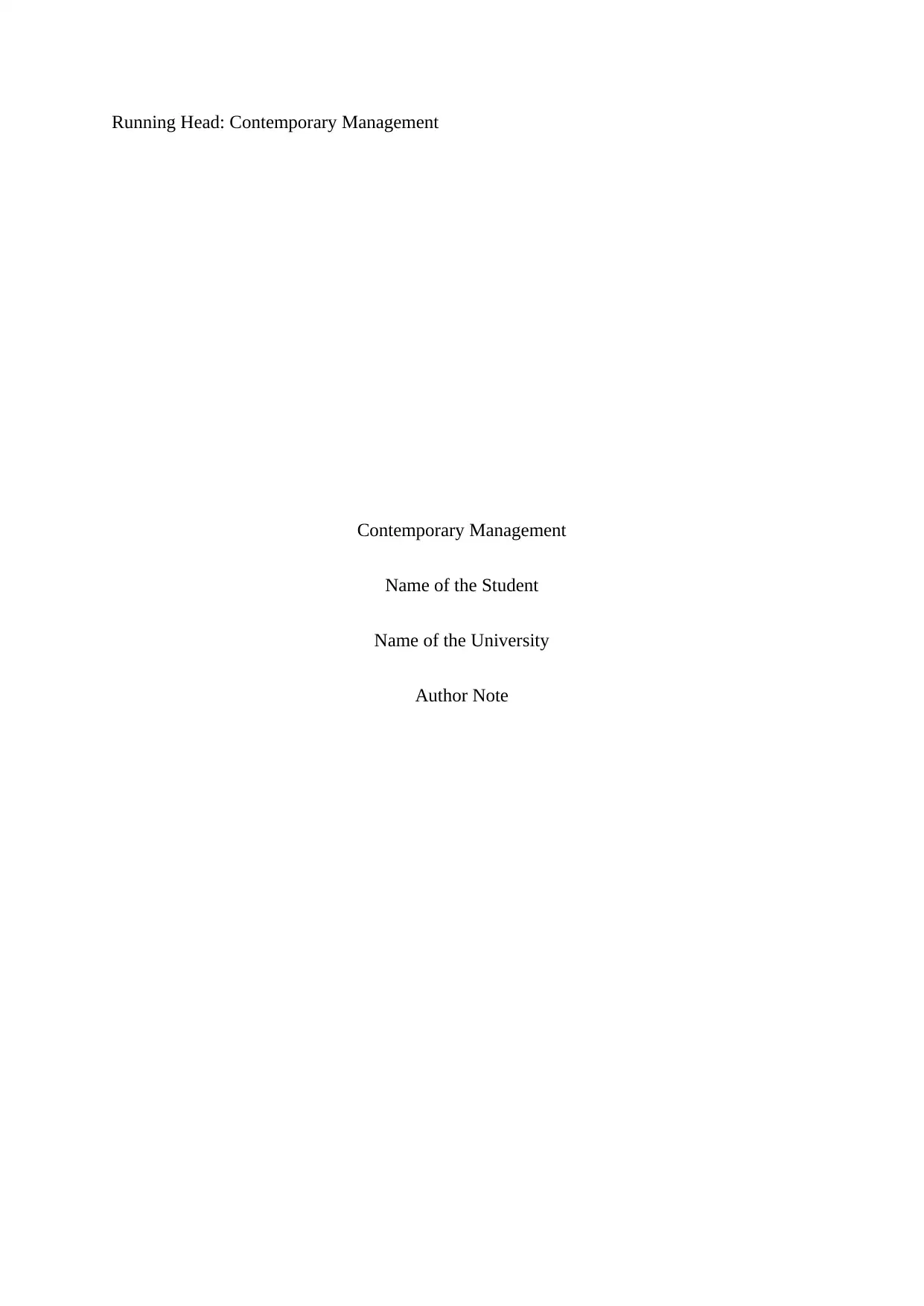
Running Head: Contemporary Management
Contemporary Management
Name of the Student
Name of the University
Author Note
Contemporary Management
Name of the Student
Name of the University
Author Note
Paraphrase This Document
Need a fresh take? Get an instant paraphrase of this document with our AI Paraphraser
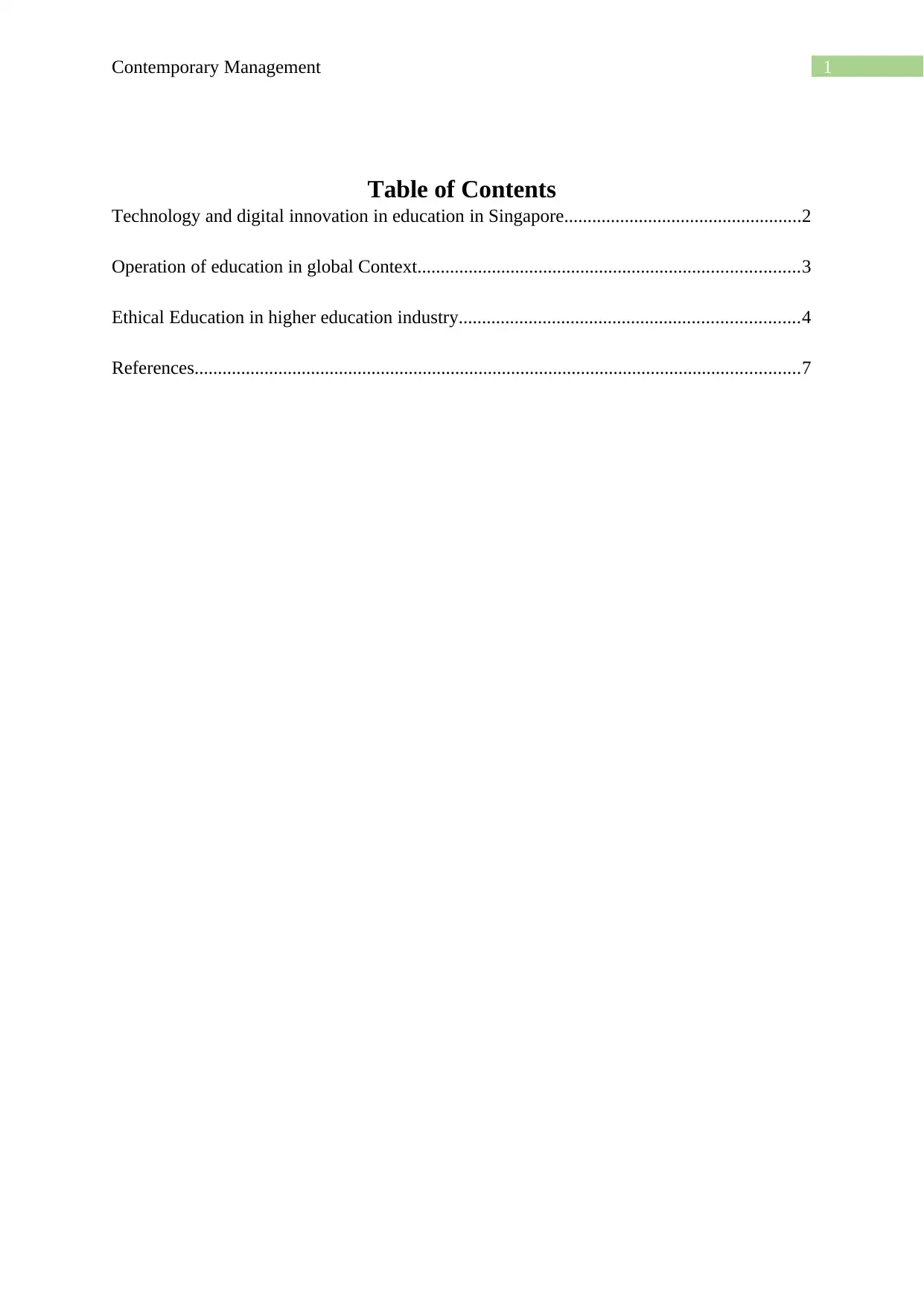
1Contemporary Management
Table of Contents
Technology and digital innovation in education in Singapore...................................................2
Operation of education in global Context..................................................................................3
Ethical Education in higher education industry.........................................................................4
References..................................................................................................................................7
Table of Contents
Technology and digital innovation in education in Singapore...................................................2
Operation of education in global Context..................................................................................3
Ethical Education in higher education industry.........................................................................4
References..................................................................................................................................7
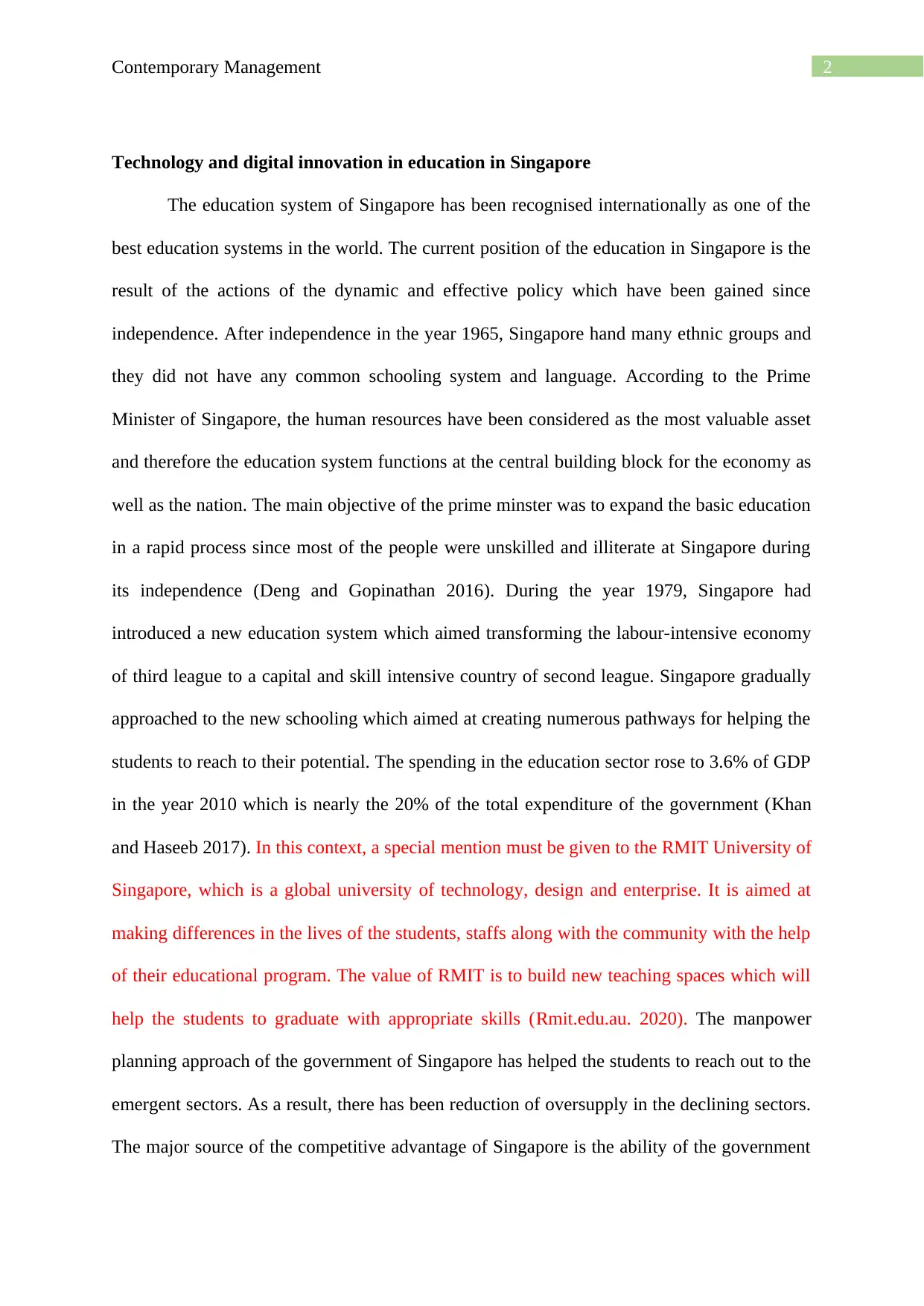
2Contemporary Management
Technology and digital innovation in education in Singapore
The education system of Singapore has been recognised internationally as one of the
best education systems in the world. The current position of the education in Singapore is the
result of the actions of the dynamic and effective policy which have been gained since
independence. After independence in the year 1965, Singapore hand many ethnic groups and
they did not have any common schooling system and language. According to the Prime
Minister of Singapore, the human resources have been considered as the most valuable asset
and therefore the education system functions at the central building block for the economy as
well as the nation. The main objective of the prime minster was to expand the basic education
in a rapid process since most of the people were unskilled and illiterate at Singapore during
its independence (Deng and Gopinathan 2016). During the year 1979, Singapore had
introduced a new education system which aimed transforming the labour-intensive economy
of third league to a capital and skill intensive country of second league. Singapore gradually
approached to the new schooling which aimed at creating numerous pathways for helping the
students to reach to their potential. The spending in the education sector rose to 3.6% of GDP
in the year 2010 which is nearly the 20% of the total expenditure of the government (Khan
and Haseeb 2017). In this context, a special mention must be given to the RMIT University of
Singapore, which is a global university of technology, design and enterprise. It is aimed at
making differences in the lives of the students, staffs along with the community with the help
of their educational program. The value of RMIT is to build new teaching spaces which will
help the students to graduate with appropriate skills (Rmit.edu.au. 2020). The manpower
planning approach of the government of Singapore has helped the students to reach out to the
emergent sectors. As a result, there has been reduction of oversupply in the declining sectors.
The major source of the competitive advantage of Singapore is the ability of the government
Technology and digital innovation in education in Singapore
The education system of Singapore has been recognised internationally as one of the
best education systems in the world. The current position of the education in Singapore is the
result of the actions of the dynamic and effective policy which have been gained since
independence. After independence in the year 1965, Singapore hand many ethnic groups and
they did not have any common schooling system and language. According to the Prime
Minister of Singapore, the human resources have been considered as the most valuable asset
and therefore the education system functions at the central building block for the economy as
well as the nation. The main objective of the prime minster was to expand the basic education
in a rapid process since most of the people were unskilled and illiterate at Singapore during
its independence (Deng and Gopinathan 2016). During the year 1979, Singapore had
introduced a new education system which aimed transforming the labour-intensive economy
of third league to a capital and skill intensive country of second league. Singapore gradually
approached to the new schooling which aimed at creating numerous pathways for helping the
students to reach to their potential. The spending in the education sector rose to 3.6% of GDP
in the year 2010 which is nearly the 20% of the total expenditure of the government (Khan
and Haseeb 2017). In this context, a special mention must be given to the RMIT University of
Singapore, which is a global university of technology, design and enterprise. It is aimed at
making differences in the lives of the students, staffs along with the community with the help
of their educational program. The value of RMIT is to build new teaching spaces which will
help the students to graduate with appropriate skills (Rmit.edu.au. 2020). The manpower
planning approach of the government of Singapore has helped the students to reach out to the
emergent sectors. As a result, there has been reduction of oversupply in the declining sectors.
The major source of the competitive advantage of Singapore is the ability of the government
⊘ This is a preview!⊘
Do you want full access?
Subscribe today to unlock all pages.

Trusted by 1+ million students worldwide
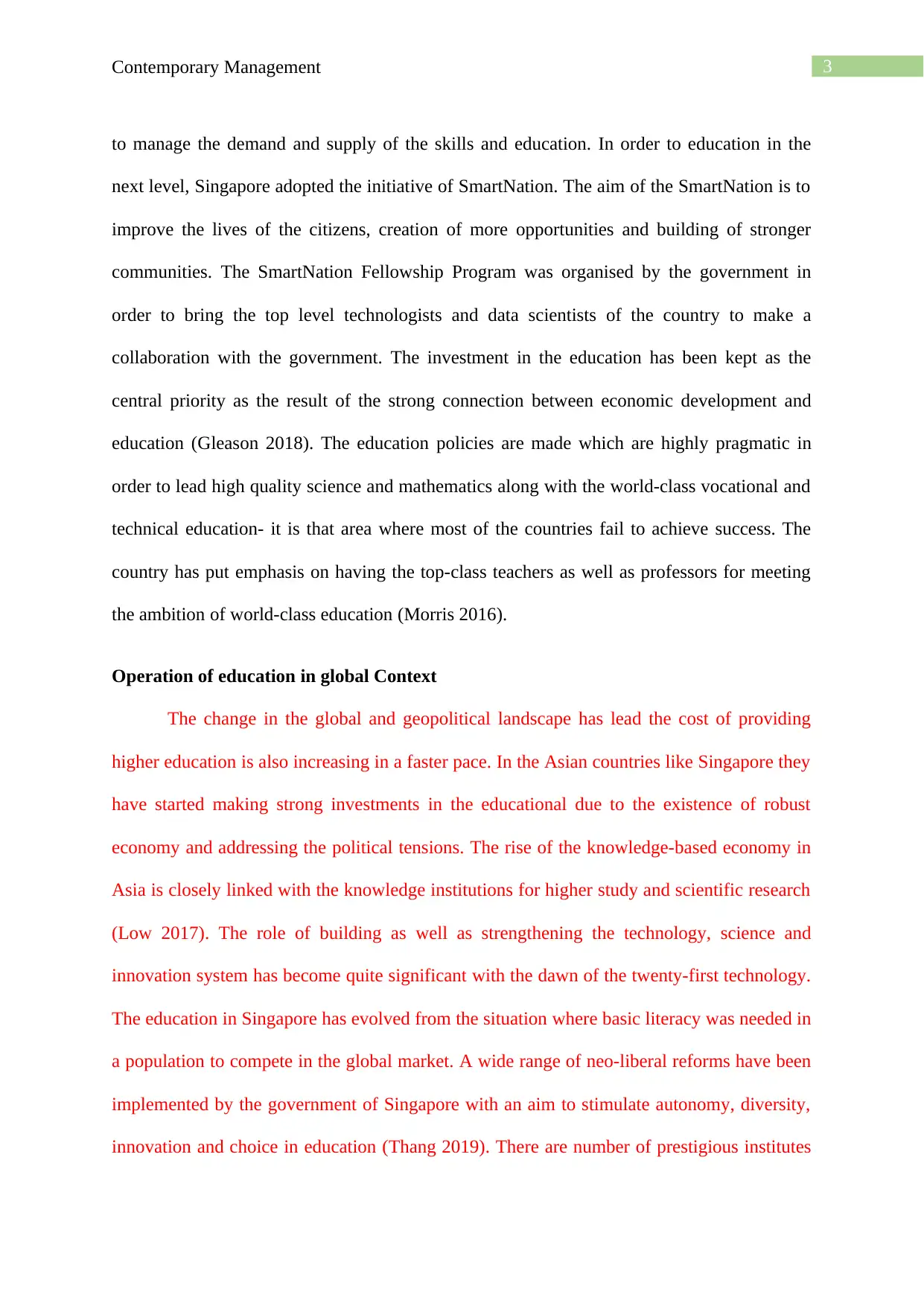
3Contemporary Management
to manage the demand and supply of the skills and education. In order to education in the
next level, Singapore adopted the initiative of SmartNation. The aim of the SmartNation is to
improve the lives of the citizens, creation of more opportunities and building of stronger
communities. The SmartNation Fellowship Program was organised by the government in
order to bring the top level technologists and data scientists of the country to make a
collaboration with the government. The investment in the education has been kept as the
central priority as the result of the strong connection between economic development and
education (Gleason 2018). The education policies are made which are highly pragmatic in
order to lead high quality science and mathematics along with the world-class vocational and
technical education- it is that area where most of the countries fail to achieve success. The
country has put emphasis on having the top-class teachers as well as professors for meeting
the ambition of world-class education (Morris 2016).
Operation of education in global Context
The change in the global and geopolitical landscape has lead the cost of providing
higher education is also increasing in a faster pace. In the Asian countries like Singapore they
have started making strong investments in the educational due to the existence of robust
economy and addressing the political tensions. The rise of the knowledge-based economy in
Asia is closely linked with the knowledge institutions for higher study and scientific research
(Low 2017). The role of building as well as strengthening the technology, science and
innovation system has become quite significant with the dawn of the twenty-first technology.
The education in Singapore has evolved from the situation where basic literacy was needed in
a population to compete in the global market. A wide range of neo-liberal reforms have been
implemented by the government of Singapore with an aim to stimulate autonomy, diversity,
innovation and choice in education (Thang 2019). There are number of prestigious institutes
to manage the demand and supply of the skills and education. In order to education in the
next level, Singapore adopted the initiative of SmartNation. The aim of the SmartNation is to
improve the lives of the citizens, creation of more opportunities and building of stronger
communities. The SmartNation Fellowship Program was organised by the government in
order to bring the top level technologists and data scientists of the country to make a
collaboration with the government. The investment in the education has been kept as the
central priority as the result of the strong connection between economic development and
education (Gleason 2018). The education policies are made which are highly pragmatic in
order to lead high quality science and mathematics along with the world-class vocational and
technical education- it is that area where most of the countries fail to achieve success. The
country has put emphasis on having the top-class teachers as well as professors for meeting
the ambition of world-class education (Morris 2016).
Operation of education in global Context
The change in the global and geopolitical landscape has lead the cost of providing
higher education is also increasing in a faster pace. In the Asian countries like Singapore they
have started making strong investments in the educational due to the existence of robust
economy and addressing the political tensions. The rise of the knowledge-based economy in
Asia is closely linked with the knowledge institutions for higher study and scientific research
(Low 2017). The role of building as well as strengthening the technology, science and
innovation system has become quite significant with the dawn of the twenty-first technology.
The education in Singapore has evolved from the situation where basic literacy was needed in
a population to compete in the global market. A wide range of neo-liberal reforms have been
implemented by the government of Singapore with an aim to stimulate autonomy, diversity,
innovation and choice in education (Thang 2019). There are number of prestigious institutes
Paraphrase This Document
Need a fresh take? Get an instant paraphrase of this document with our AI Paraphraser
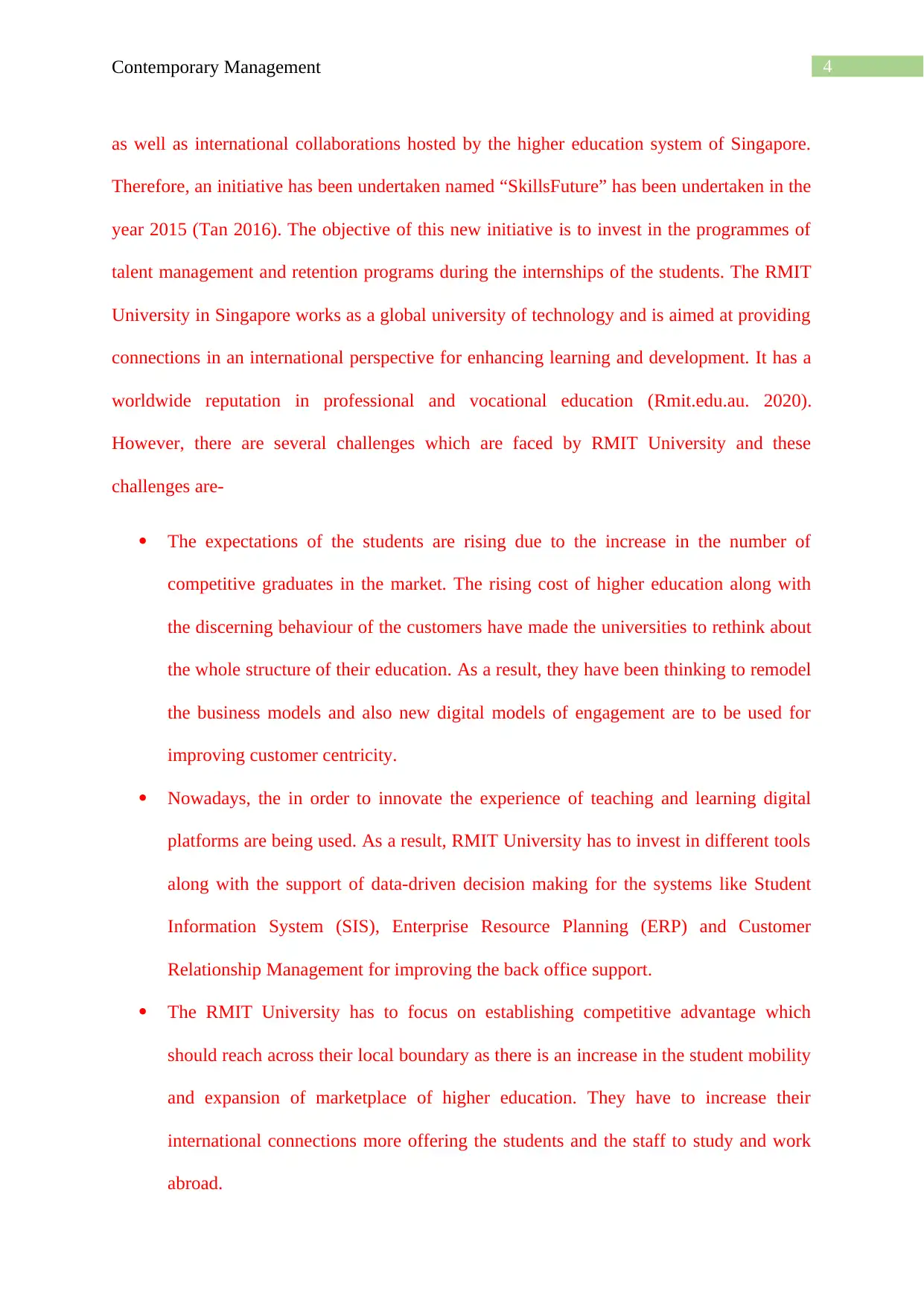
4Contemporary Management
as well as international collaborations hosted by the higher education system of Singapore.
Therefore, an initiative has been undertaken named “SkillsFuture” has been undertaken in the
year 2015 (Tan 2016). The objective of this new initiative is to invest in the programmes of
talent management and retention programs during the internships of the students. The RMIT
University in Singapore works as a global university of technology and is aimed at providing
connections in an international perspective for enhancing learning and development. It has a
worldwide reputation in professional and vocational education (Rmit.edu.au. 2020).
However, there are several challenges which are faced by RMIT University and these
challenges are-
The expectations of the students are rising due to the increase in the number of
competitive graduates in the market. The rising cost of higher education along with
the discerning behaviour of the customers have made the universities to rethink about
the whole structure of their education. As a result, they have been thinking to remodel
the business models and also new digital models of engagement are to be used for
improving customer centricity.
Nowadays, the in order to innovate the experience of teaching and learning digital
platforms are being used. As a result, RMIT University has to invest in different tools
along with the support of data-driven decision making for the systems like Student
Information System (SIS), Enterprise Resource Planning (ERP) and Customer
Relationship Management for improving the back office support.
The RMIT University has to focus on establishing competitive advantage which
should reach across their local boundary as there is an increase in the student mobility
and expansion of marketplace of higher education. They have to increase their
international connections more offering the students and the staff to study and work
abroad.
as well as international collaborations hosted by the higher education system of Singapore.
Therefore, an initiative has been undertaken named “SkillsFuture” has been undertaken in the
year 2015 (Tan 2016). The objective of this new initiative is to invest in the programmes of
talent management and retention programs during the internships of the students. The RMIT
University in Singapore works as a global university of technology and is aimed at providing
connections in an international perspective for enhancing learning and development. It has a
worldwide reputation in professional and vocational education (Rmit.edu.au. 2020).
However, there are several challenges which are faced by RMIT University and these
challenges are-
The expectations of the students are rising due to the increase in the number of
competitive graduates in the market. The rising cost of higher education along with
the discerning behaviour of the customers have made the universities to rethink about
the whole structure of their education. As a result, they have been thinking to remodel
the business models and also new digital models of engagement are to be used for
improving customer centricity.
Nowadays, the in order to innovate the experience of teaching and learning digital
platforms are being used. As a result, RMIT University has to invest in different tools
along with the support of data-driven decision making for the systems like Student
Information System (SIS), Enterprise Resource Planning (ERP) and Customer
Relationship Management for improving the back office support.
The RMIT University has to focus on establishing competitive advantage which
should reach across their local boundary as there is an increase in the student mobility
and expansion of marketplace of higher education. They have to increase their
international connections more offering the students and the staff to study and work
abroad.
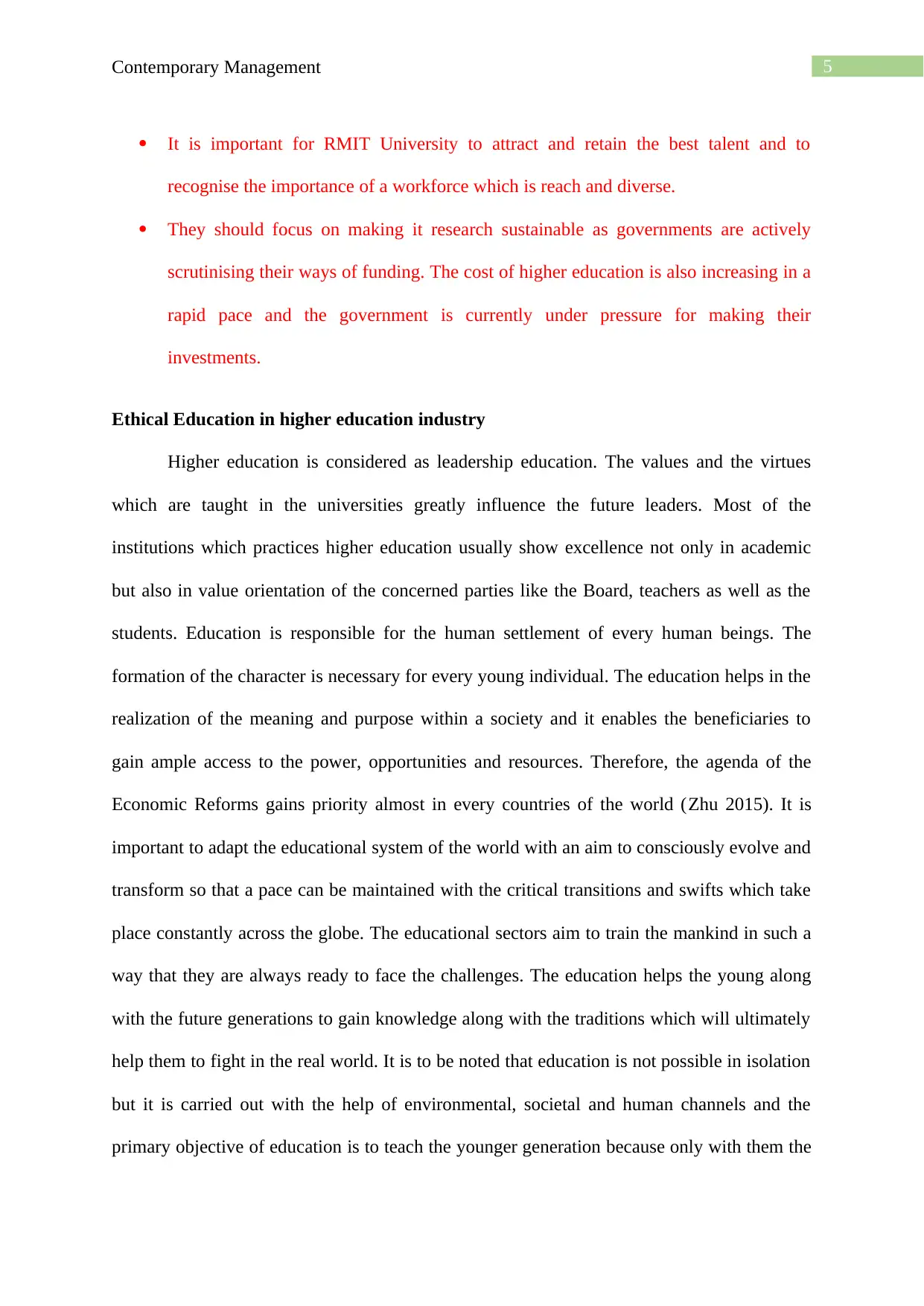
5Contemporary Management
It is important for RMIT University to attract and retain the best talent and to
recognise the importance of a workforce which is reach and diverse.
They should focus on making it research sustainable as governments are actively
scrutinising their ways of funding. The cost of higher education is also increasing in a
rapid pace and the government is currently under pressure for making their
investments.
Ethical Education in higher education industry
Higher education is considered as leadership education. The values and the virtues
which are taught in the universities greatly influence the future leaders. Most of the
institutions which practices higher education usually show excellence not only in academic
but also in value orientation of the concerned parties like the Board, teachers as well as the
students. Education is responsible for the human settlement of every human beings. The
formation of the character is necessary for every young individual. The education helps in the
realization of the meaning and purpose within a society and it enables the beneficiaries to
gain ample access to the power, opportunities and resources. Therefore, the agenda of the
Economic Reforms gains priority almost in every countries of the world (Zhu 2015). It is
important to adapt the educational system of the world with an aim to consciously evolve and
transform so that a pace can be maintained with the critical transitions and swifts which take
place constantly across the globe. The educational sectors aim to train the mankind in such a
way that they are always ready to face the challenges. The education helps the young along
with the future generations to gain knowledge along with the traditions which will ultimately
help them to fight in the real world. It is to be noted that education is not possible in isolation
but it is carried out with the help of environmental, societal and human channels and the
primary objective of education is to teach the younger generation because only with them the
It is important for RMIT University to attract and retain the best talent and to
recognise the importance of a workforce which is reach and diverse.
They should focus on making it research sustainable as governments are actively
scrutinising their ways of funding. The cost of higher education is also increasing in a
rapid pace and the government is currently under pressure for making their
investments.
Ethical Education in higher education industry
Higher education is considered as leadership education. The values and the virtues
which are taught in the universities greatly influence the future leaders. Most of the
institutions which practices higher education usually show excellence not only in academic
but also in value orientation of the concerned parties like the Board, teachers as well as the
students. Education is responsible for the human settlement of every human beings. The
formation of the character is necessary for every young individual. The education helps in the
realization of the meaning and purpose within a society and it enables the beneficiaries to
gain ample access to the power, opportunities and resources. Therefore, the agenda of the
Economic Reforms gains priority almost in every countries of the world (Zhu 2015). It is
important to adapt the educational system of the world with an aim to consciously evolve and
transform so that a pace can be maintained with the critical transitions and swifts which take
place constantly across the globe. The educational sectors aim to train the mankind in such a
way that they are always ready to face the challenges. The education helps the young along
with the future generations to gain knowledge along with the traditions which will ultimately
help them to fight in the real world. It is to be noted that education is not possible in isolation
but it is carried out with the help of environmental, societal and human channels and the
primary objective of education is to teach the younger generation because only with them the
⊘ This is a preview!⊘
Do you want full access?
Subscribe today to unlock all pages.

Trusted by 1+ million students worldwide
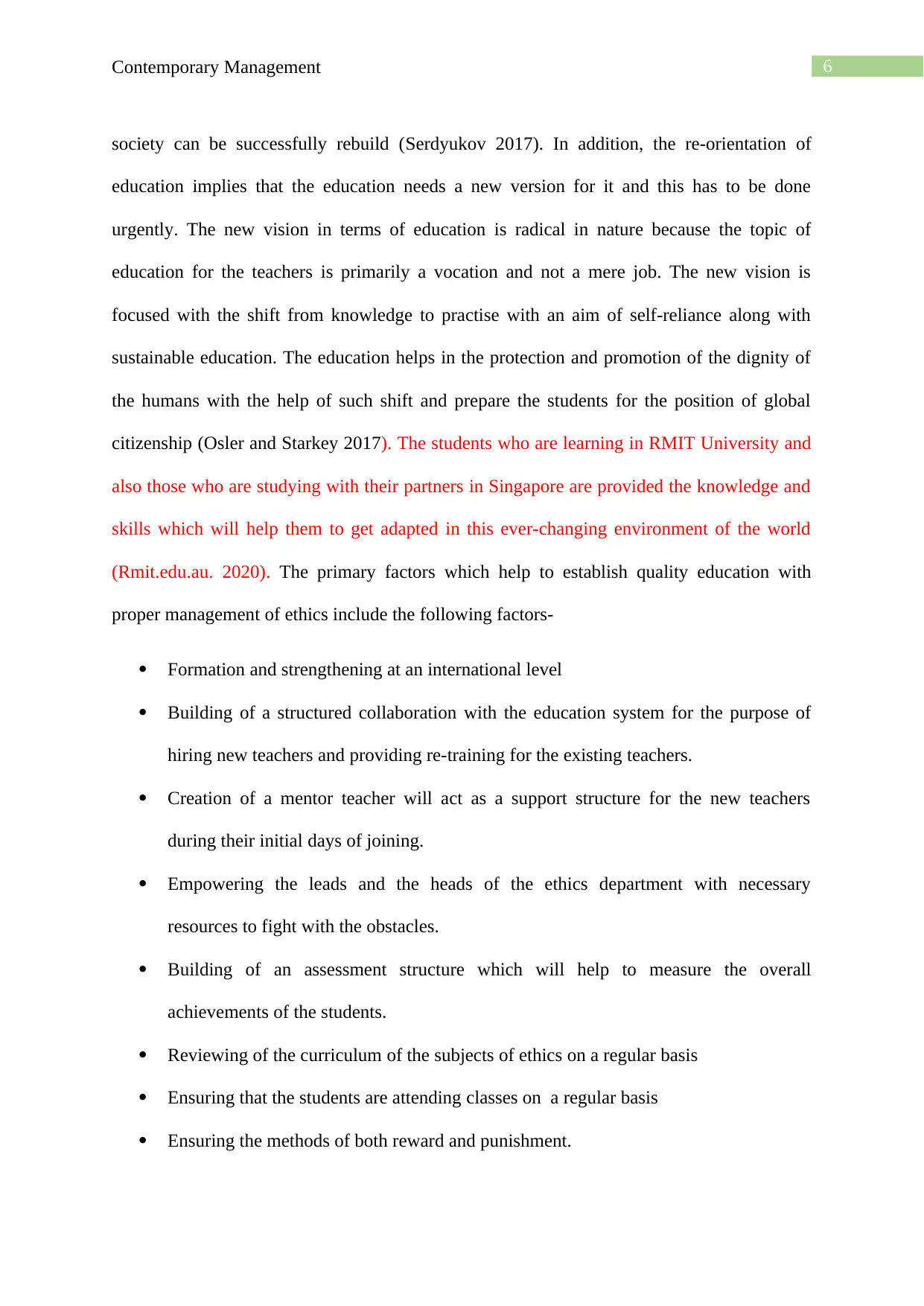
6Contemporary Management
society can be successfully rebuild (Serdyukov 2017). In addition, the re-orientation of
education implies that the education needs a new version for it and this has to be done
urgently. The new vision in terms of education is radical in nature because the topic of
education for the teachers is primarily a vocation and not a mere job. The new vision is
focused with the shift from knowledge to practise with an aim of self-reliance along with
sustainable education. The education helps in the protection and promotion of the dignity of
the humans with the help of such shift and prepare the students for the position of global
citizenship (Osler and Starkey 2017). The students who are learning in RMIT University and
also those who are studying with their partners in Singapore are provided the knowledge and
skills which will help them to get adapted in this ever-changing environment of the world
(Rmit.edu.au. 2020). The primary factors which help to establish quality education with
proper management of ethics include the following factors-
Formation and strengthening at an international level
Building of a structured collaboration with the education system for the purpose of
hiring new teachers and providing re-training for the existing teachers.
Creation of a mentor teacher will act as a support structure for the new teachers
during their initial days of joining.
Empowering the leads and the heads of the ethics department with necessary
resources to fight with the obstacles.
Building of an assessment structure which will help to measure the overall
achievements of the students.
Reviewing of the curriculum of the subjects of ethics on a regular basis
Ensuring that the students are attending classes on a regular basis
Ensuring the methods of both reward and punishment.
society can be successfully rebuild (Serdyukov 2017). In addition, the re-orientation of
education implies that the education needs a new version for it and this has to be done
urgently. The new vision in terms of education is radical in nature because the topic of
education for the teachers is primarily a vocation and not a mere job. The new vision is
focused with the shift from knowledge to practise with an aim of self-reliance along with
sustainable education. The education helps in the protection and promotion of the dignity of
the humans with the help of such shift and prepare the students for the position of global
citizenship (Osler and Starkey 2017). The students who are learning in RMIT University and
also those who are studying with their partners in Singapore are provided the knowledge and
skills which will help them to get adapted in this ever-changing environment of the world
(Rmit.edu.au. 2020). The primary factors which help to establish quality education with
proper management of ethics include the following factors-
Formation and strengthening at an international level
Building of a structured collaboration with the education system for the purpose of
hiring new teachers and providing re-training for the existing teachers.
Creation of a mentor teacher will act as a support structure for the new teachers
during their initial days of joining.
Empowering the leads and the heads of the ethics department with necessary
resources to fight with the obstacles.
Building of an assessment structure which will help to measure the overall
achievements of the students.
Reviewing of the curriculum of the subjects of ethics on a regular basis
Ensuring that the students are attending classes on a regular basis
Ensuring the methods of both reward and punishment.
Paraphrase This Document
Need a fresh take? Get an instant paraphrase of this document with our AI Paraphraser
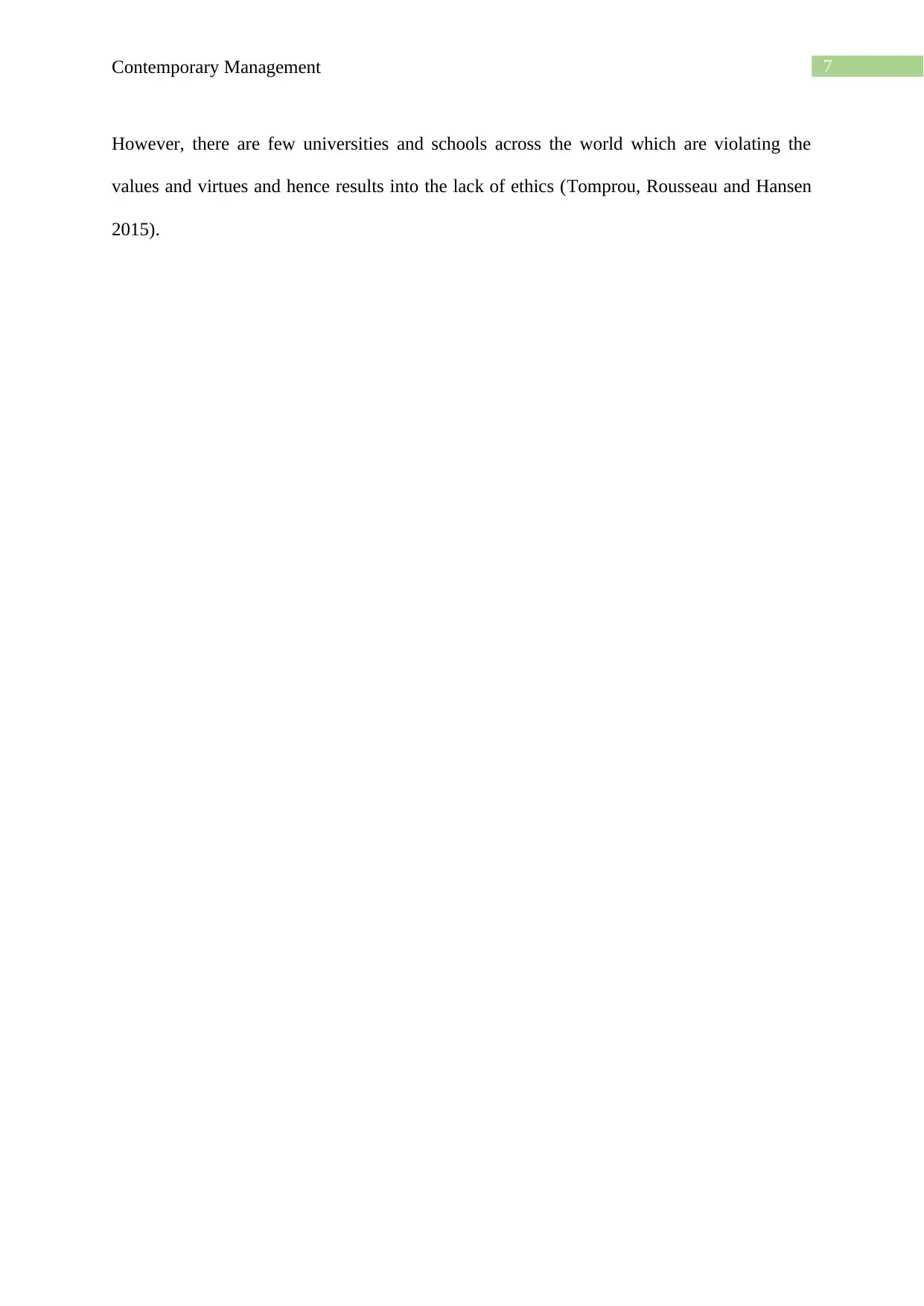
7Contemporary Management
However, there are few universities and schools across the world which are violating the
values and virtues and hence results into the lack of ethics (Tomprou, Rousseau and Hansen
2015).
However, there are few universities and schools across the world which are violating the
values and virtues and hence results into the lack of ethics (Tomprou, Rousseau and Hansen
2015).
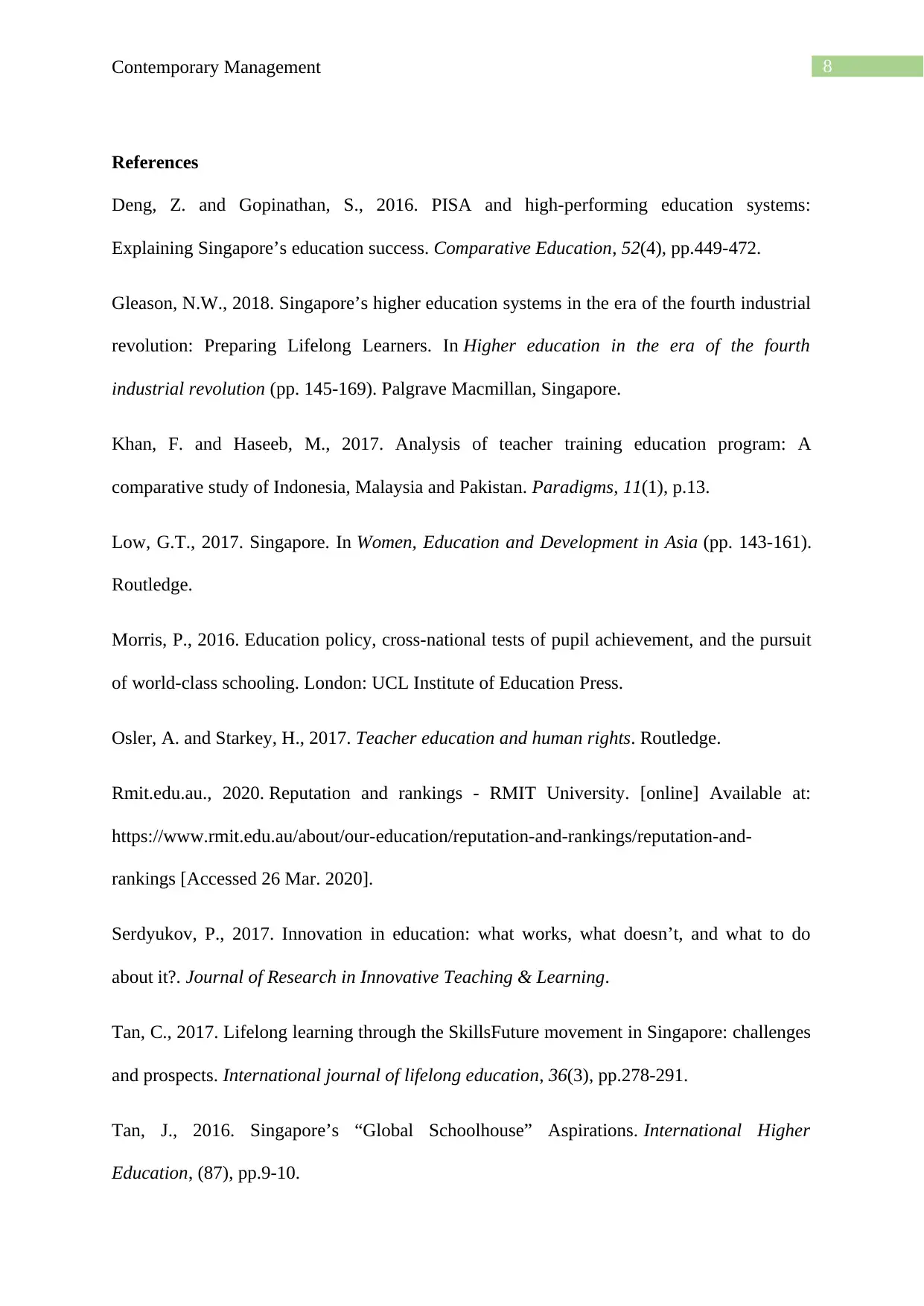
8Contemporary Management
References
Deng, Z. and Gopinathan, S., 2016. PISA and high-performing education systems:
Explaining Singapore’s education success. Comparative Education, 52(4), pp.449-472.
Gleason, N.W., 2018. Singapore’s higher education systems in the era of the fourth industrial
revolution: Preparing Lifelong Learners. In Higher education in the era of the fourth
industrial revolution (pp. 145-169). Palgrave Macmillan, Singapore.
Khan, F. and Haseeb, M., 2017. Analysis of teacher training education program: A
comparative study of Indonesia, Malaysia and Pakistan. Paradigms, 11(1), p.13.
Low, G.T., 2017. Singapore. In Women, Education and Development in Asia (pp. 143-161).
Routledge.
Morris, P., 2016. Education policy, cross-national tests of pupil achievement, and the pursuit
of world-class schooling. London: UCL Institute of Education Press.
Osler, A. and Starkey, H., 2017. Teacher education and human rights. Routledge.
Rmit.edu.au., 2020. Reputation and rankings - RMIT University. [online] Available at:
https://www.rmit.edu.au/about/our-education/reputation-and-rankings/reputation-and-
rankings [Accessed 26 Mar. 2020].
Serdyukov, P., 2017. Innovation in education: what works, what doesn’t, and what to do
about it?. Journal of Research in Innovative Teaching & Learning.
Tan, C., 2017. Lifelong learning through the SkillsFuture movement in Singapore: challenges
and prospects. International journal of lifelong education, 36(3), pp.278-291.
Tan, J., 2016. Singapore’s “Global Schoolhouse” Aspirations. International Higher
Education, (87), pp.9-10.
References
Deng, Z. and Gopinathan, S., 2016. PISA and high-performing education systems:
Explaining Singapore’s education success. Comparative Education, 52(4), pp.449-472.
Gleason, N.W., 2018. Singapore’s higher education systems in the era of the fourth industrial
revolution: Preparing Lifelong Learners. In Higher education in the era of the fourth
industrial revolution (pp. 145-169). Palgrave Macmillan, Singapore.
Khan, F. and Haseeb, M., 2017. Analysis of teacher training education program: A
comparative study of Indonesia, Malaysia and Pakistan. Paradigms, 11(1), p.13.
Low, G.T., 2017. Singapore. In Women, Education and Development in Asia (pp. 143-161).
Routledge.
Morris, P., 2016. Education policy, cross-national tests of pupil achievement, and the pursuit
of world-class schooling. London: UCL Institute of Education Press.
Osler, A. and Starkey, H., 2017. Teacher education and human rights. Routledge.
Rmit.edu.au., 2020. Reputation and rankings - RMIT University. [online] Available at:
https://www.rmit.edu.au/about/our-education/reputation-and-rankings/reputation-and-
rankings [Accessed 26 Mar. 2020].
Serdyukov, P., 2017. Innovation in education: what works, what doesn’t, and what to do
about it?. Journal of Research in Innovative Teaching & Learning.
Tan, C., 2017. Lifelong learning through the SkillsFuture movement in Singapore: challenges
and prospects. International journal of lifelong education, 36(3), pp.278-291.
Tan, J., 2016. Singapore’s “Global Schoolhouse” Aspirations. International Higher
Education, (87), pp.9-10.
⊘ This is a preview!⊘
Do you want full access?
Subscribe today to unlock all pages.

Trusted by 1+ million students worldwide
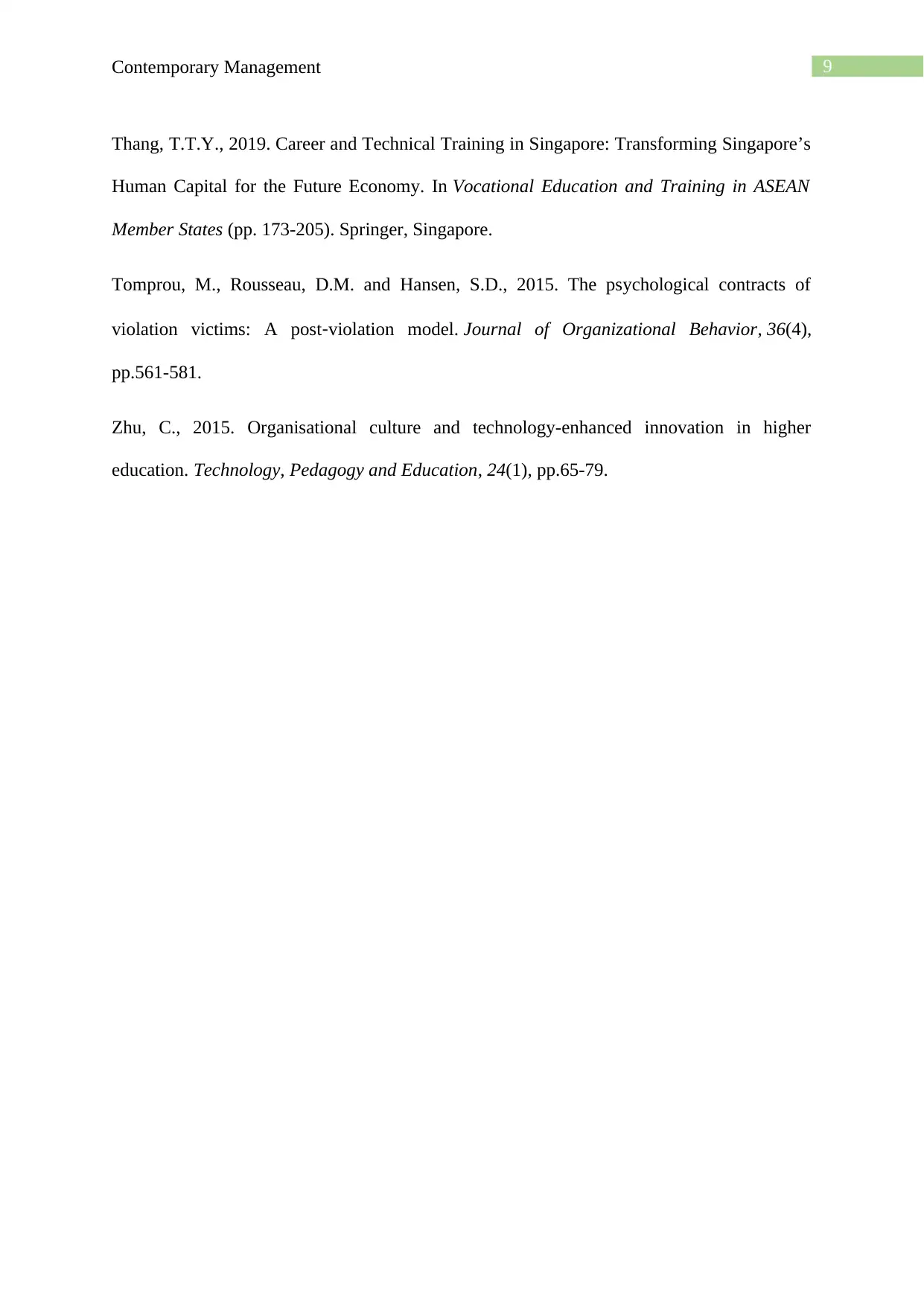
9Contemporary Management
Thang, T.T.Y., 2019. Career and Technical Training in Singapore: Transforming Singapore’s
Human Capital for the Future Economy. In Vocational Education and Training in ASEAN
Member States (pp. 173-205). Springer, Singapore.
Tomprou, M., Rousseau, D.M. and Hansen, S.D., 2015. The psychological contracts of
violation victims: A post‐violation model. Journal of Organizational Behavior, 36(4),
pp.561-581.
Zhu, C., 2015. Organisational culture and technology-enhanced innovation in higher
education. Technology, Pedagogy and Education, 24(1), pp.65-79.
Thang, T.T.Y., 2019. Career and Technical Training in Singapore: Transforming Singapore’s
Human Capital for the Future Economy. In Vocational Education and Training in ASEAN
Member States (pp. 173-205). Springer, Singapore.
Tomprou, M., Rousseau, D.M. and Hansen, S.D., 2015. The psychological contracts of
violation victims: A post‐violation model. Journal of Organizational Behavior, 36(4),
pp.561-581.
Zhu, C., 2015. Organisational culture and technology-enhanced innovation in higher
education. Technology, Pedagogy and Education, 24(1), pp.65-79.
1 out of 10
Related Documents
Your All-in-One AI-Powered Toolkit for Academic Success.
+13062052269
info@desklib.com
Available 24*7 on WhatsApp / Email
![[object Object]](/_next/static/media/star-bottom.7253800d.svg)
Unlock your academic potential
Copyright © 2020–2025 A2Z Services. All Rights Reserved. Developed and managed by ZUCOL.





